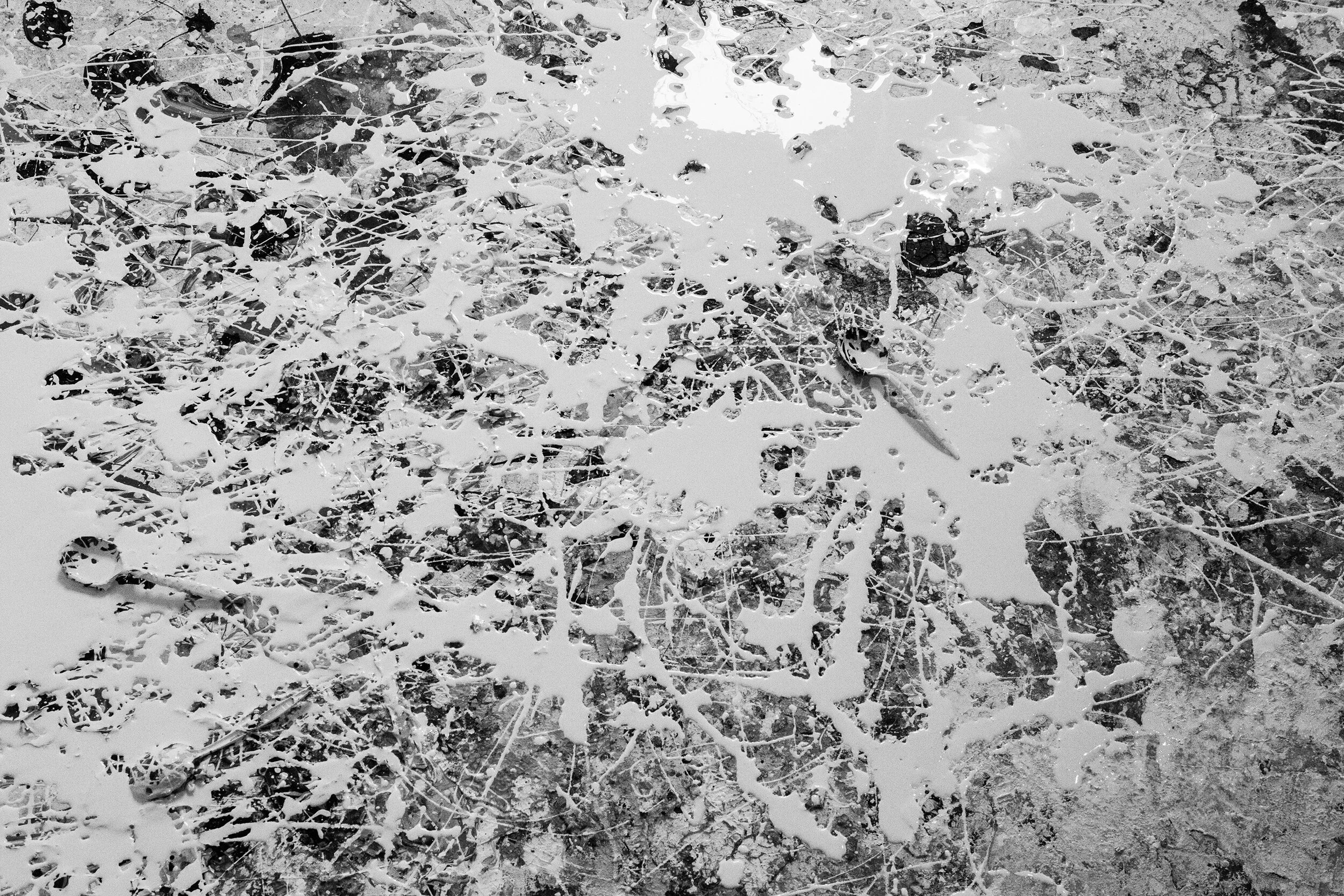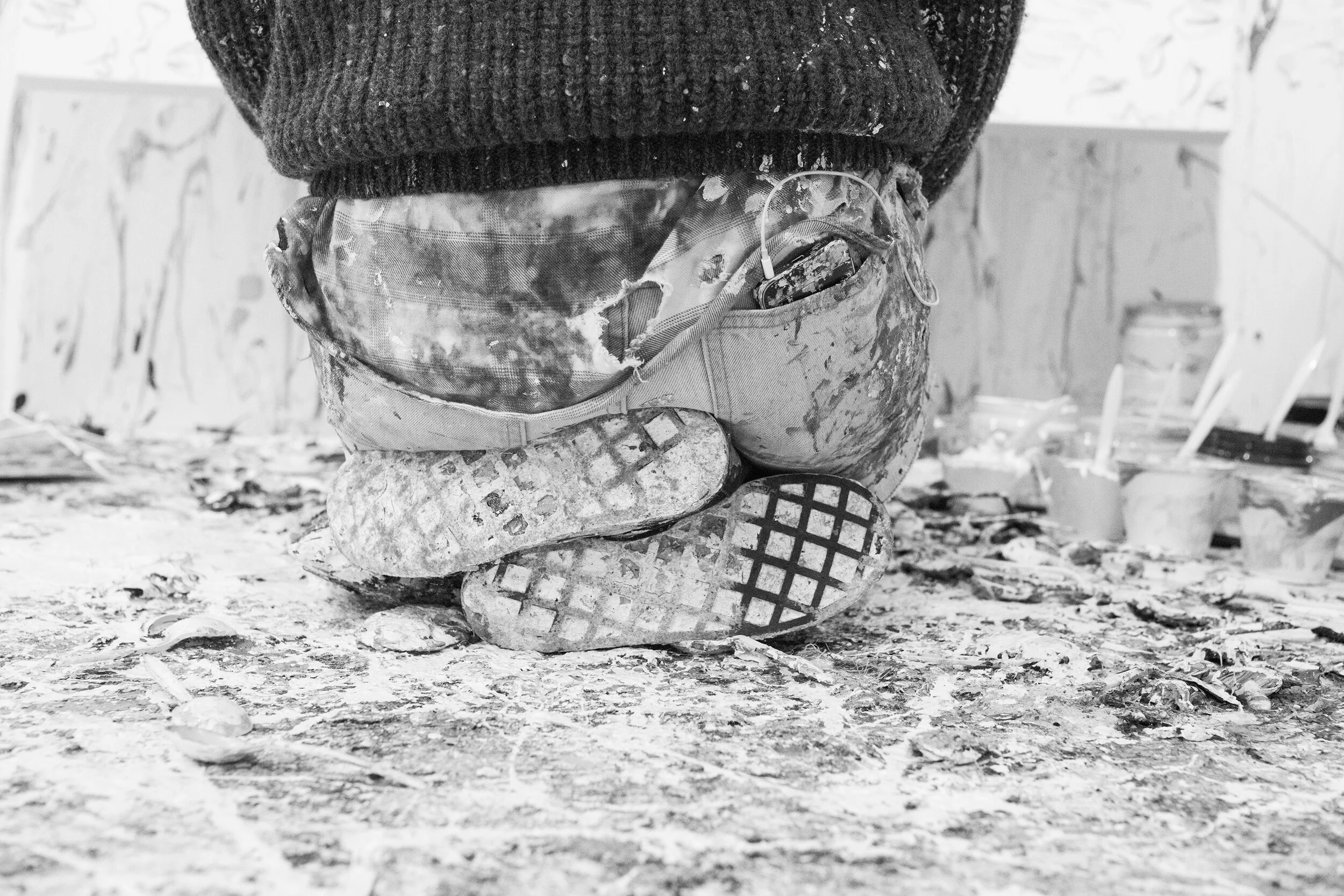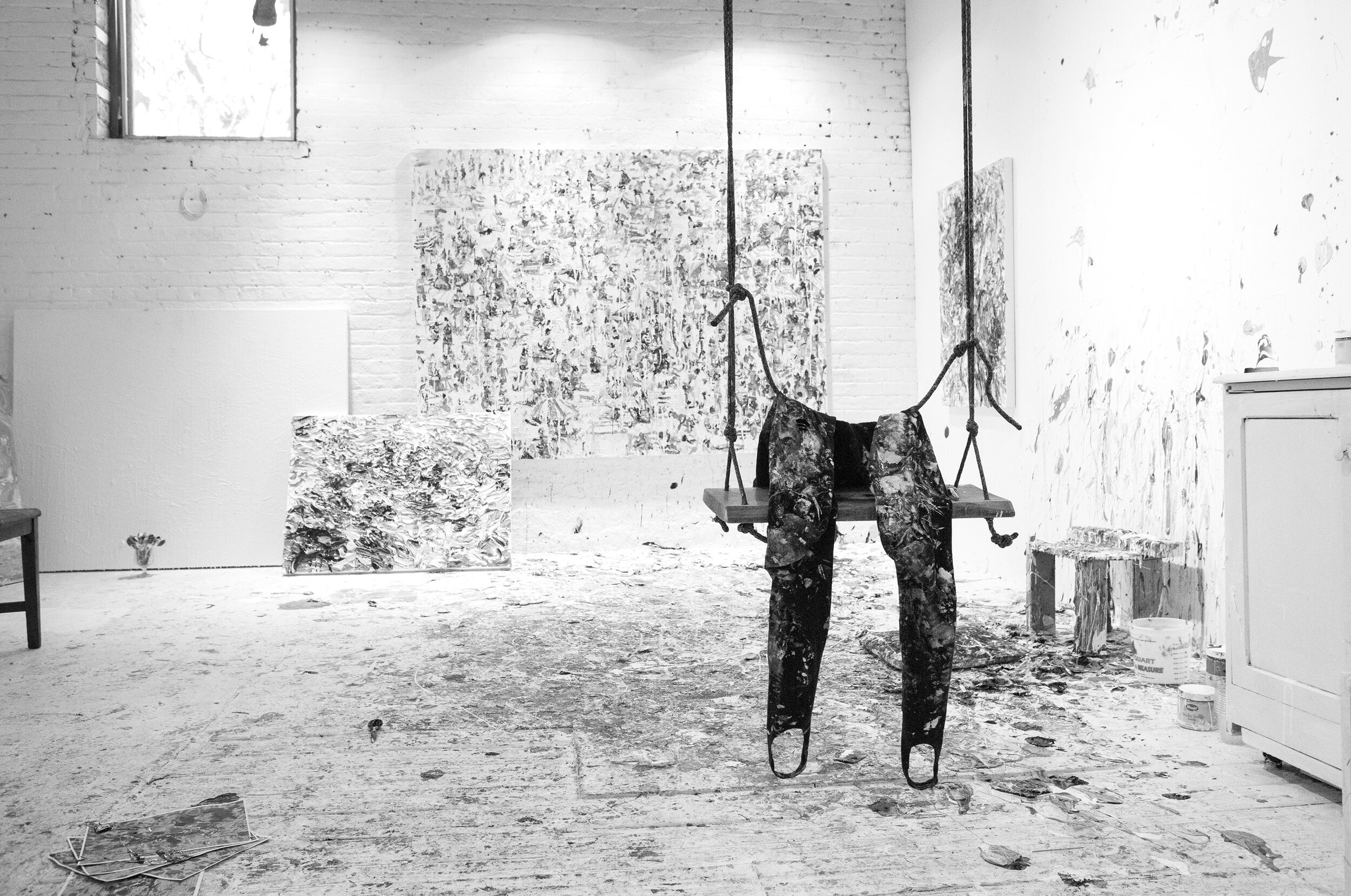CHRISSY ANGLIKER

“Paint became my greatest teacher once I stopped rendering it into submission, and ceded control to its nature.”
Interview by Amanda Quinn Olivar, Editor
Chrissy Angliker is a Brooklyn-based Swiss American Artist. Born in Zurich, Switzerland, and raised in Greifensee and Winterthur, Angliker’s artistic inclinations emerged at an early age. Beginning in 1996 she was fortunate to study with the Russian artist Juri Borodatchev, who became her artistic mentor for several years. In 1999 at age 16, Chrissy moved to the US to study Fine Art at the Walnut Hill School in Natick, Mass. In 2002, Chrissy had her first solo show at Gallery Juri in Winterthur, Switzerland. Seeking to broaden her means of expression, she then pursued a degree in Industrial Design at the Pratt Institute in New York. After spending her post-graduate years working in the design field, the artist’s creative expression shifted back to painting in 2008. Her art is focused on visually translating how she perceives life itself, as seeking balance between control and chaos. Over the past several years Chrissy’s work has been regularly selling out at shows in Europe and the US. She has been featured in several publications, including Forbes online in 2017, and in the summer of 2018 her new nude paintings were included on Tate Modern’s Instagram account to accompany the theme of the ‘All to Human’ exhibit. She has been commissioned to collaborate with several companies, amongst them AOL, Burton, and Wired Magazine. Her most recent Solo shows were in December 2018 at Stalla Madulain in Switzerland, and June 2019 at Craig Krull Gallery in Santa Monica, California.
Amanda Quinn Olivar: Why do you make art... and what’s exciting to you?
Chrissy Angliker: I’m constantly processing the happenings around me. I draw inspiration from nature, and the people and relationships in my life. To me the world is highly charged, completely abstract, unknowable, and I believe that’s why I’m a figurative painter. I’m constantly trying to makes sense of and mirror back to myself, what I perceive around and inside of me. I’m a sensitive person and fill up with emotions very quickly. Once I’m full I have to release those emotions, and the most effective way is by retreating to the studio and transferring those emotions into paintings. Once I’m empty I can go out there and fill back up again. That said the process of painting is essential for me to lead a balanced life.
Lia’s Hands, 2019, acrylic on canvas, 16 x 20 inches
Glide, 2019, acrylic on canvas, 16 x 20 inches
Amanda: How did your upbringing influence your path?
Chrissy: I grew up in Switzerland and at an early age Swiss culture instills in you the sense that all things have their designated place in society. Everything is on time and in order and there is a structure to follow, pretty black and white. If you find yourself in a gray area you’re pretty screwed. I discovered my love and need for art at a young age, but too young I was told, or too old; too young to be taken serious[ly] and too old to be cute.
I was encouraged to direct that passion to something proper and less frivolous. At age 13 I met my mentor Juri Borodatchev and that changed everything. When I first met Juri he couldn’t speak German yet. We could only communicate with the marks we made. That was profound for me because I saw that we were communicating fluently and that mark-making was my language. I saw how fluent Juri was in his language and I wanted to become as fluent in mine. I struggled with reading and writing in school and here was the language I felt comfortable in. Later on I asked Juri about the place of an artist in the world. He said, “There are farmers, bankers, schoolteachers who all have a job and a set place in the world. The artist doesn’t because he is between worlds. He sits at God’s feet and his job is to listen to his whispers.” That right there is as gray as it gets. Up until meeting Juri I had never met a person that mirrored my being and could help me make sense of my dilemma. By him standing in his calling as an artist he gave me permission to fully step in mine.
Catching Rays, 2018, acrylic on canvas, 14 x 18 inches
Amanda: Let’s talk about your subject matter and your focus...
Chrissy: I tend to have recurring subject matters of nature, people and intimacy. Revisiting past subjects over and over is both a comfort and also readiness to push deeper. One recurring theme is bodies of water. The term “bodies of water” carries a dual meaning... It refers to humans, whose bodies are essentially made up of water, and also those vast watery places that make up the majority of the earth’s surface. In my paintings, people submerge themselves in water in various ways and various attitudes, while in essence being mostly composed of water themselves. The human body and the banks of a river, are both vessels for the same element. Water is an essential component of their composition, and also the intermediary between these vessels. My medium, paint, is similarly an intermediary between two worlds, the conscious and subconscious. I don’t attempt to paint the people or the water specifically, or to illuminate the conscious or the subconscious mind. These are the players with which I try to touch that vibrating, invisible line, where those worlds meet and the unknown seeps through.
I’ve also been deepening my study of bodies by focusing on the female nude. My attention is on the expansion and contraction between the entirety and individualism of what is the divine female. Similar to the bodies of water subject, by bringing a group of female friends together, I seek to study the dynamic of those faceted worlds colliding.
Big Dip, 2019, acrylic on canvas, 48 x 60 inches
Big Dip (detail), 2019, acrylic on canvas, 48 x 60 inches
Amanda: Is painting your medium of choice? You were quoted saying “I react to the nature of my medium…” What does that mean?
Chrissy: Yes, painting is my medium of choice and my muse! In my practice, paint and I have become equal collaborators, and that is why I aim to influence paint instead of manipulating it.
Amanda: When we spoke last year at your Craig Krull Gallery opening in Santa Monica, I was captivated by your work: textures and gestures of color... seemingly placed with wild abandon but perfectly executed—beautiful images of bodies and nature. You told me about your technique and process... would you recap that for our readers?
Chrissy: I believe that you learn from that which you do not know. This idea reverberates within me every time I interact with paint. Paint teaches me things I didn’t know about painting. All the uncontrolled and unintentional marks that happen during the process of painting (which as they occur I consider a loss of control of my medium and myself), end up gradually broadening my visual horizon of paint’s natural vocabulary. I discovered this perspective through a series of accidents. Experimentation is a fundamental and at this stage a completely organic part in my painting process.
Giving my medium proper reverence has been an ongoing journey. Paint became my greatest teacher once I stopped rendering it into submission, and ceded control to its nature. When I’m at a loss, I give paint more room in the process and allow myself to become an observer.
This practice of learning from my medium has also led me to look beyond the canvas. Through regular practice, I became increasingly sensitive to how paint wanted to move. I started to allow paint to travel naturally from the canvas into the surrounding space. Within the same brushstroke or spoon toss a mark can travel through my peripheral vision and into the still and infinite space beyond.
For me, the boundaries of the canvas represent the limits of conscious thought. I deliberately eschew the checks and balances that attend conscious control of the strokes of the brush or the flick of the spoon. I make no attempt to control the limits of those gestures. I regard the marks that spill beyond the boundaries of the canvas—the most wild and exaggerated extensions of my medium—as an expression of the unconscious mind.
I expanded my perspective from simply learning from the marks of paint on the canvas, to studying the vocabulary of marks that occur outside of my conscious painting process. This conscious expansion leads me back to my core belief of learning from that which one does not know. I have become a witness and collaborator within a fascinating cycle through which my medium travels. It is a sublime sequence—one which I am positive I will never be able to fully grasp, similar to my subject, life itself.
Angliker at work in her studio (detail shots), 2019, photo credit: Ebru Yildiz
Amanda: What is important to you about the visual experiences you create?
Chrissy: Even though the process of painting belongs fully to me I always hold space for the viewer. I want the paintings to feel open and accessible to them. As mentioned earlier, for me the paintings are vessels where I get to unload my emotions... The paintings are filled with emotional currency for the viewer to access. When I paint I extend as wide as possible the gap between the paint marks and the illusion that is created with the marks. The bigger the gap, the more space for the viewer to interpret and project their own experience. My desire is that the viewer is able to see the paint separately, like the microscopic cells from which an image gets created. That way I let them in on my intimate dialogue with the paint.
Amanda: Do you recall if any particular artwork made an impact on you as a child?
Chrissy: When I was eleven I came across Salvador Dali’s work. It just completely blew my little mind. I loved that he was able to show an alternate version of reality, which I believed was his true reality. I think it spoke to me so clearly because I also felt that what I saw out there was way crazier then what it led on. That was the first time I felt seen and understood by art.
Above: detail video of Pusher Beach, 2020, acrylic on canvas, 48 x 48 inches
Desert Pool, 2017, acrylic on canvas, 36 x 48 inches
Amanda: What is your favorite art accident... Did it change your perspective?
For college I was “encouraged” to peruse something more steadfast than art and I ended up studying Industrial design at Pratt Institute. For me to be able to do that I had to stop painting to create the need to express myself through design. That worked for six years. Finally, the time came where I just couldn’t take it anymore. I was going through a very tough time in my life and decided to step away from my New York life for a month to go home to Switzerland to check in with painting.
For the first two weeks I was paralyzed and couldn’t touch paint. I didn’t know where to begin because paint felt foreign to me after so long. Finally, I forced myself to try and paint a small self-portrait. During that attempt the medium dripped when I didn’t intend it to. My unexpected emotional reaction to this mishap made me pay attention to what was really transpiring on the canvas in front of me. I was experiencing loss of control. It was something that I was feeling at that time in my life, but I could never have captured it more truthfully than when I suddenly lost control during the act of painting. The paint in that instance became a mirror of how I perceived life itself: as a struggle to maintain a balance between control and chaos.
There was nothing simulated or manipulated about my response to the paint. It was honest and undeniable. In that moment, I had a critical realization: the paint and I were in dialogue! In my process, paint is not only a tool to achieve communication; it simultaneously is the communicator with whom I’m in dialogue about my subject. Paint has its own nature, and therefore its own voice. Through that experience I was able to finally articulate to myself the difference between art and design and why I needed to choose art for myself. For me design is about creating things for the world, where art is creating about the world. I haven’t stopped honoring paint and my relationship since that pivotal moment.
Self-Portrait I, 2008, acrylic, ink on paper, 19 x 24 inches
Chrissy Angliker in her studio, 2019, photo by Ebru Yildiz
Feature portrait by Michael O’Shea







